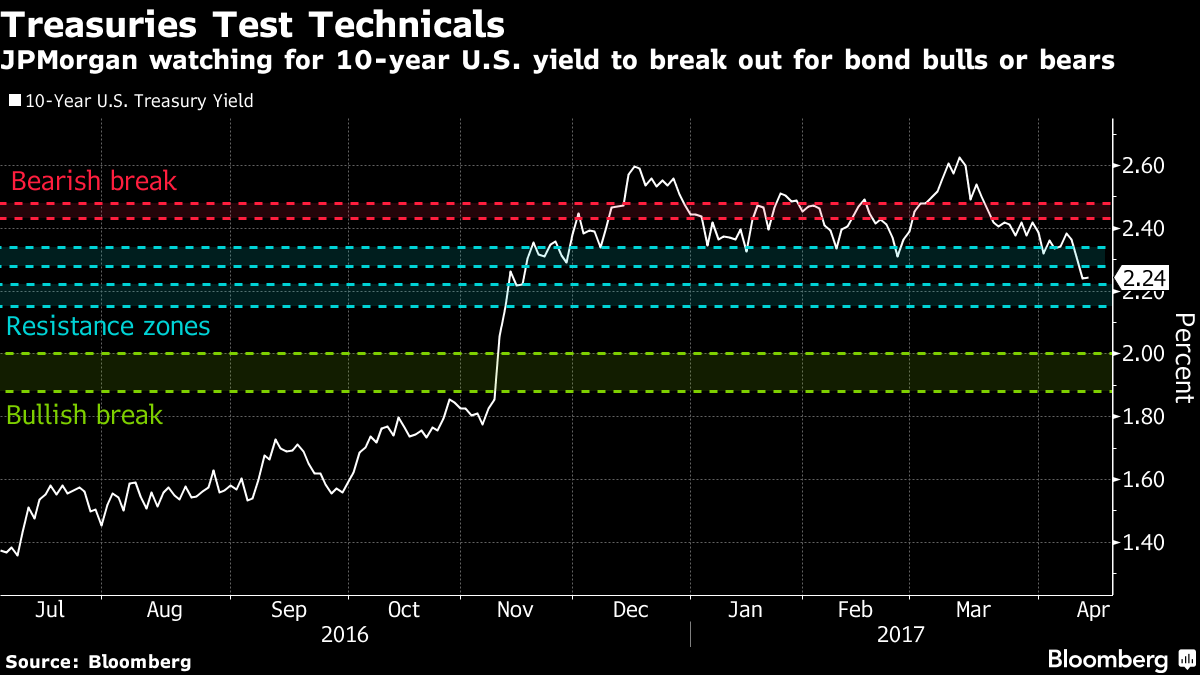The world's biggest bond market may have finally broken out ofits tight 2017 trading range, but it's not exactly drawing a clearroadmap for traders of the moves ahead.
|Rather than gaining more insight into the plight of the globalreflation bet, traders were left reacting to geopolitical risksfrom North Korea to Russia (not to mention a huge bomb dropped inAfghanistan just before holiday-shortened trading ended). They alsoheard President Donald Trump jawboning the dollar lower anddeclaring he likes low interest rates now that he's in the OvalOffice. Those factors seem unlikely to disappear in the weeksahead.
|That leaves the benchmark 10-year U.S. yield at 2.24%, near thelowest this year, and the dollar about the weakest versus the yensince November, heading into a relatively quiet week for economicdata. Rather than overreact to something like housing starts,traders and strategists are keying in on technical market levels togauge the sustainability of the latest move.
|“North Korea and Syria were the straw that broke the camel'sback, but now we have a new range,” said Glen Capelo, a trader atMischler Financial. He pegs it at about 2.05% to 2.4% for the10-year yield, after it'd been stuck between 2.3% and 2.65%.
|For bond bears, “we're not going to know anything for a while,”on the timing of Trump's fiscal-policy agenda, Capelo said. “Theonus now is that the hard data has to turn higher.”
|In the meantime, Wall Street strategists are chiming in withtheir own levels to watch in the trading days ahead.
|For the rally to continue, the 10-year yield has to fall below2.15%, according to JPMorgan Chase & Co. technical analystsJason Hunter and Alix Tepper. If it does, the yield could plungeall the way back to 1.88%. It'll meet resistance at the 2.34% levelon the way up, they said in a note.
|Even though technicals back a further rally, targeting the 50%retracement of the Trumponomics sell-off at 2.177%, Ian Lyngen andAaron Kohli at BMO Capital Markets say they aren't buying it.
|“While we'd like to lean more bullishly on the market, theseverity of the move coupled with the spike in short-dated impliedvolatility has us viewing a sideways grinding consolidation as thepath of least resistance,” they wrote in a note Friday.
|The dollar, for its part, is hovering around its 200-day movingaverage and its 12-month average closing price, 108.79 and 108.40yen respectively. A drop in yields could compromise both levels anddrag the dollar to as low as 103.33, the first standard deviationfrom the mean 12-month closing price. Such a fall would align witha roughly 2% 10-year yield.
|A decline of that magnitude in the 10-year yield before the endof June would surprise even the most bullish of the 58 analystssurveyed by Bloomberg as of April 13.
|As usual, Steven Major at HSBC Holdings is tied for the lowestestimate — 2.2% — when the current quarter comes to an end. He'smaintaining a decline to 1.6% by year-end.
|Sounds outlandish? Sounds plausible? Well, traders, yields havebroken free. Place your bets.
|
Bloomberg News
|Copyright 2018 Bloomberg. All rightsreserved. This material may not be published, broadcast, rewritten,or redistributed.
Complete your profile to continue reading and get FREE access to Treasury & Risk, part of your ALM digital membership.
Your access to unlimited Treasury & Risk content isn’t changing.
Once you are an ALM digital member, you’ll receive:
- Critical Treasury & Risk information including in-depth analysis of treasury and finance best practices, case studies with corporate innovators, informative newsletters, educational webcasts and videos, and resources from industry leaders.
- Exclusive discounts on ALM and Treasury & Risk events.
- Access to other award-winning ALM websites including PropertyCasualty360.com and Law.com.
*May exclude premium content
Already have an account? Sign In
© 2024 ALM Global, LLC, All Rights Reserved. Request academic re-use from www.copyright.com. All other uses, submit a request to [email protected]. For more information visit Asset & Logo Licensing.







